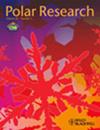Diversity and distribution of heterotrophic flagellates in seawater of the Powell Basin, Antarctic Peninsula
IF 1.3
4区 地球科学
Q3 ECOLOGY
引用次数: 0
Abstract
Heterotrophic flagellates are essential components of the marine microbial food web. However, how the changes in flagellate populations reflect environmental changes in marine ecosystems is still unclear, especially in polar regions. In this study, we used pyrosequencing to examine the community structure of heterotrophic flagellates (HFs) in the Powell Basin’s surface waters of the northern Antarctic Peninsula. OTUs (operational taxonomic units) of different taxa and the correlations between community structure and environmental factors were analysed. Eight taxa of HFs were selected for the principal analysis: Telonemia, Picozoa, Rhizaria, Amoebozoa, Apusomonas, Centrohelida, Choanomonada and marine stramenopiles (MASTs). The HFs were defined as heterotrophic picoflagellates (HPFs; <3 μm) and heterotrophic nanoflagellates (HNFs; >3 μm, <20 μm), which had similar dominant phyla (MASTs and Telonemia). However, their taxonomic composition differed. Environmental factors exerted similar effects on the community structure of both HPFs and HNPs. Compared with the correlation between HPF and environmental factors, the correlation between HNF and environmental factors was stronger. Salinity, bacterial biomass and the biological interactions amongst dominant taxa were the main variables to influence the diversity and community structure of HFs.南极半岛鲍威尔盆地海水中异养鞭毛虫的多样性和分布
异养鞭毛虫是海洋微生物食物网的重要组成部分。然而,鞭毛虫种群的变化如何反映海洋生态系统的环境变化仍不清楚,尤其是在极地地区。在这项研究中,我们使用热解测序来检查南极半岛北部鲍威尔盆地地表水中异养鞭毛虫(HFs)的群落结构。分析了不同类群的OTU(操作分类单元)以及群落结构与环境因子的相关性。选择了8个HFs分类群进行主要分析:Telonemia、Picozoa、Rhizaria、Amoebozoa、Apusomonas、Centrohelida、Choanomonada和marine stramenopiles(MASTs)。HFs被定义为异养微微鞭毛虫(HPFs;3μm,<20μm),具有相似的优势门(MASTs和Telonemia)。然而,它们的分类组成各不相同。环境因素对HPF和HNP的群落结构产生了相似的影响。与HPF与环境因素的相关性相比,HNF与环境因子的相关性更强。盐度、细菌生物量和优势类群之间的生物相互作用是影响HFs多样性和群落结构的主要变量。
本文章由计算机程序翻译,如有差异,请以英文原文为准。
求助全文
约1分钟内获得全文
求助全文
来源期刊

Polar Research
地学-地球科学综合
CiteScore
3.20
自引率
5.30%
发文量
22
审稿时长
>12 weeks
期刊介绍:
Since 1982, Polar Research has been the international, peer-reviewed journal of the Norwegian Polar Institute, Norway''s central institution for research, environmental monitoring and mapping of the polar regions. Aiming to promote the exchange of scientific knowledge about the Arctic and Antarctic across disciplinary boundaries, Polar Research serves an international community of researchers and managers. As an open-access journal, Polar Research makes its contents freely available to the general public.
Original primary research papers comprise the mainstay of Polar Research. Review articles, brief research notes, letters to the editor and book reviews are also included. Special issues are published from time to time.
The scope of Polar Research encompasses research in all scientific disciplines relevant to the polar regions. These include, but are not limited to, the subfields of biology, ecology, geology, oceanography, glaciology and atmospheric science. Submissions from the social sciences and those focusing on polar management and policy issues are welcome. Contributions about Antarctica are particularly encouraged.
 求助内容:
求助内容: 应助结果提醒方式:
应助结果提醒方式:


